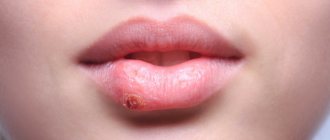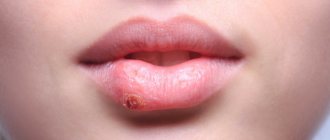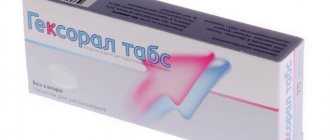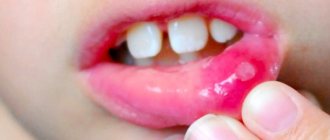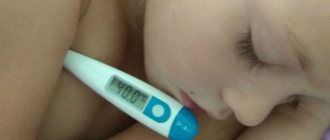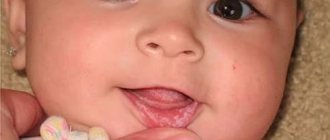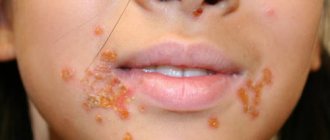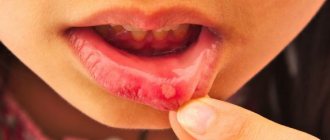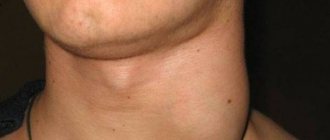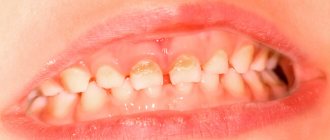The problem of allergic reactions is very acute in infants and slightly older children. And the point here is not only in the reaction to external stimuli, but in the body’s increased sensitivity to them. Therefore, to treat diathesis in children, it is not enough to simply exclude the allergenic factor. An integrated approach to therapy is important, which will help minimize the impact of all possible causes of the occurrence and exacerbation of diathesis.
Causes of diathesis in children
Diathesis in an infant on the cheeks or other parts of the body is not a specific disease, but a predisposition to the development of pathological reactions to irritants. This is considered a feature of the body that determines its reactivity. At the same time, against the background of diathesis, certain diseases may develop under the influence of unfavorable factors.
The causes of diathesis itself can be:
- unfavorable course of pregnancy;
- past infectious diseases during pregnancy;
- abuse of medications and bad habits during pregnancy;
- hypoxia or asphyxia of the fetus during childbirth;
- too little or too much birth weight;
- pathologies of the central nervous system;
- artificial feeding;
- dysbacteriosis;
- chronic diseases;
- insufficient or poor care;
- vaccination.
Journal "Child's Health" 6(9) 2007
Cheilitis (lip disease) is an inflammation of the red border, skin and mucous membrane of the lips. The clinical features of cheilitis are determined by the morphological and functional maturity of the integumentary tissues of the lips. It is customary to distinguish between independent and symptomatic cheilitis.
Independent cheilitis includes: traumatic, exfoliative, contact allergic, meteorological, glandular, microbial cheilitis. Depending on the nature of the course, acute and chronic diseases of the lips are distinguished.
Traumatic cheilitis develops as a result of damage to the lips (mechanical, chemical, thermal) and subsequent infection. The mucous membrane of the lip is clearly hyperemic, swollen, and tense. There is pain and limited mobility. Sometimes cheilitis is observed in children as a complication of mycotic, herpetic lesions. Treatment consists of prescribing antibacterial therapy: gentamicin, synthomycin, irrigation with inhalipt, as well as other antiseptic and anti-inflammatory drugs.
Exfoliative cheilitis is manifested by peeling of the red border of the lips (usually the lower) and has a chronic course. According to ICD-10, K 13.0 is classified as diseases of the lips, including exfoliative cheilitis. An important role in the occurrence of this type of cheilitis is played by incomplete, incorrect closure of the lips, hypovitaminosis of ascorbic or nicotinic acids, B vitamins, dysfunction of the central nervous system, and the thyroid gland. Exfoliative cheilitis has dry and exudative forms. In the dry form, gray or grayish-brown scales appear on the red border. The scales fall off easily, the adjacent mucous membranes are not damaged. Children complain of dry lips and the appearance of scales. The exudative form is manifested by the appearance of grayish-yellow or yellowish-brown crusts on the red border, sometimes large in size and hanging from the lip when rejected. After removing the crusts, a bright red, smooth surface is visible, there are no erosions. Patients are concerned about a burning sensation, soreness, tension in the lips, and their swelling.
Treatment consists of maintaining nasal breathing and restoring full, correct closure of the lips. Local applications of natural oils and vitamin-containing substances are prescribed: carotoline, rosehip oil, retinol, carophylene ointment. Creams are widely used: “Calendula”, “Spermaceti”. The presence of an exudative form determines the prescription of boric or boron-vaseline ointment.
Contact allergic cheilitis is more common in children over 7 years of age and is a reflection of a delayed-type allergic reaction. The reason for it is the contact of the mucous membrane of the lips with various chemicals (the habit of holding various objects in the mouth, sometimes a reaction to certain elixirs, toothpaste). Clinically, erythema forms on the mucous membrane and peeling begins.
In some cases, against the background of inflammation, small blisters appear, after opening which become weeping. Children complain of itching, dryness, burning in the lips. Treatment consists of immediately stopping contact with the allergen and prescribing antihistamines. Anti-inflammatory therapy is carried out locally - 1% solution of mephenamine, 1% solution of salicylic acid, treatment of lips with anesthetic with glycerin. If treatment is ineffective, use hormonal ointments for a short course of up to 4-6 days.
Meteorological cheilitis occurs when exposed to cold, wind, solar radiation, and high humidity. Hyperemia and infiltration of the lips appear, their surface is dry and may be covered with crusts. Children complain of a burning sensation and a feeling of tightening of the lips. Treatment involves eliminating the factors that caused cheilitis and prescribing photoprotective fatty creams and ointments. In severe cases, hormonal ointments are used for a short time.
Glandular cheilitis is an inflammation of the minor salivary glands of the lips (chronic). According to ICD-10, K 13.0 is classified as diseases of the lips, including glandular cheilitis. The presence of a congenital anomaly of the salivary glands, lip biting, chronic injuries, a psychogenic factor, and genetic predisposition are important. Teenagers get sick more often. They are concerned about dryness, soreness, peeling of the lips, cracks, erosion, maceration. The excretory ducts of the minor salivary glands are dilated, the mucous membrane of the lips is bright red. The chronic course of the disease causes an increase in lip volume. When pressing on the lips, a secretion is released from the glands in the form of transparent or cloudy drops.
Treatment consists of prescribing antibiotic ointments, hormonal drugs, and electrocoagulation of the salivary glands. According to indications, antibiotics are used either intramuscularly or intramuscularly, sulfonamides, and general ultraviolet radiation.
Microbial cheilitis is most often caused by streptococcal infection or Candida fungi. The disease is more common in young children with reduced immunological reactivity. Children complain of swelling of the lips, peeling, pain, and cracks. There are chronic streptococcal and mycotic cheilitis. In weakened children, streptococcal impetigo is sometimes diagnosed. A phlyctena (a type of abscess) with serous-purulent, then purulent contents is formed. After a few days, crusts form at the site of the conflicts, and when removed, erosion occurs. This disease is contagious. If a repeated staphylococcal infection occurs, vulgar impetigo develops, manifested by severe itching. The results of bacteriological examination determine the treatment tactics. General hygienic approaches are combined with oral sanitation and antibiotic therapy. The most commonly used are gentamicin ointment and cream, syntamicin liniment, furacilin, rivanol ointments and ointments containing zinc oxide. For pyoderma and purulent processes on the lips, a 2% aqueous and alcoholic solution of brilliant green is used.
Symptomatic cheilitis includes atopic, eczematous, macrocheilitis, and hypovitaminosis.
Atopic cheilitis is characterized by a chronic course and manifests itself as atopic dermatosis or diffuse neurodermatitis. A significant role in the occurrence of the disease belongs to the factors that cause atopic allergies (exo- and endoallergens). Diseases of the digestive system and nutritional disorders are of particular importance. An exacerbation of the disease is usually observed in the cold season.
Erythema with a clearly defined border and swelling appear on the red border of the lips and adjacent areas. The child is bothered by itching, and later crusts appear. After relief of acute inflammation, lichenification of the lips is observed, the red border is infiltrated, and swelling of the lips is noted. Small radial grooves on the red border and slight peeling are detected. Lichenification of the lips is a characteristic manifestation of atopic cheilitis and is manifested by thickening of the skin, intensification of its pattern and impaired pigmentation.
Treatment consists of prescribing antihistamines and vitamins. Sometimes histaglobulin is used, and in severe cases, corticosteroids are used. In parallel, antibacterial, anti-inflammatory drugs, and ointments with corticosteroids are used locally. For lichenification and infiltration, ointments with naphthalan and sulfur are used. Of particular importance is a properly selected diet, excluding spicy foods and limiting carbohydrates.
Eczematous cheilitis is one of the manifestations of a serious disease - eczema. A significant role is played by food, microbial, chemical, and drug allergens. In the acute form of the disease, hyperemia, swelling of the lips, merging blisters, maceration, and crusts are observed. In a chronic course, the red border is compacted due to infiltration; in some areas there are nodes, blisters, and crusts. Sometimes painful cracks and bloody crusts form. Treatment also includes antihistamines, vitamins, an elimination diet, and carbohydrate restriction. In severe cases, hormonal drugs are prescribed.
Steroid-based ointments are used locally: oxycort, lorindene, triamcinolone, dexamethasone. As improvement progresses, sulfur-tar ointment, boron-tar ointment, and 10–20% naphthalan ointment are prescribed. At night, it is recommended to lubricate your lips with ointments containing calendula, carotoline, and solcoseryl. Lubricating lips with natural fats has proven successful.
Macrocheilitis (Melkerson-Rosenthal syndrome) has a chronic relapsing course and occurs as a result of exposure to infectious and allergic factors. A decisive role is played by disruption of microcirculation of blood and lymph in the tissues of the lips. The disease begins with swelling of the lips, cracks and scales appear. The skin in the area of edema is pale, sometimes cyanotic. The thickening of the lips is uneven; when pressing with fingers, a depression is not formed. This pathology is characterized by three symptoms: macrocheilitis, folded tongue and facial paralysis, usually unilateral.
Treatment consists of prescribing prednisolone, antibiotics, and hyposensitizing drugs. Ointments with heparin and dimexide, electrophoresis with heparin, lidase, mud and paraffin treatment are used locally.
The correct closure of the lips and breathing are constantly monitored. A mandatory component of treatment is myotherapy and lip massage. The duration of the course of treatment is usually 1–1.5 months, repeated courses after 2–3 months.
Hypovitaminous cheilitis manifests itself as chronic cracked lips. A special role belongs to group B hypovitaminosis and retinol. According to ICD-10, there are E 51 - thiamine deficiency and E 53 - deficiency of other B vitamins. Failure to maintain lip and oral hygiene, bad habits of biting or licking lips contribute to the appearance of cracks. Most often, one linear, painful crack of varying depth appears. It is localized, as a rule, in the center of the lower lip (sometimes to the side of the center). In treatment, reparants of the epithelium of the mucous membrane are used - rosehip oil, carotolin, retinol, ointments of plant origin, natural oils and fats.
Symptoms of diathesis in children
If we look at the symptoms of diathesis in children in the photo, the most typical signs are crusts on the scalp and redness of the skin on the face, most often on the cheeks. For children, the exudative form of the disease is most typical. It appears at the age of 1-2 months. Characteristic symptoms of diathesis in children:
- flatulence and abdominal cramps;
- persistent diaper rash in the folds of the skin and on the buttocks;
- frequent rhinitis, otitis, bronchitis, atopic dermatitis;
- unstable weight gain;
- swelling and weeping of the affected skin.
How diathesis manifests itself in a child directly depends on the form of the disease. If with exudative skin manifestations are more often observed, then with uric acid (nervous-arthritic) the symptoms will be:
- anxiety;
- excessive excitability;
- sleep disorders;
- arthralgia;
- constipation and colitis;
- asthmatic bronchitis;
- eczema, urticaria, neurodermatitis, Quincke's edema.
Hemorrhagic diathesis in children is rare. They can be recognized by small hemorrhages and large hematomas on the body, which are accompanied by abdominal pain, vomiting with blood and stool disorders.
Manifestations and stages
Cheilosis is a common inflammatory problem. When the lip tissue is damaged, signs such as increased dryness and redness, the development of wounds and ulcers, and pain appear. Often develops due to poor ecology, irritation caused by food or chemicals. In some cases, it is caused by other diseases, that is, it acts as a symptom.
The following types of lesions are observed in children:
- traumatic;
- exfoliative;
- contact;
- meteorological;
- grandular and angular cheilitis in children;
- microbial.
The traumatic form occurs due to mechanical, chemical and other influences, after which infection develops. Swelling appears, the mucous membrane becomes tense, and lip movements become limited. In some cases, this type of cheilitis is caused by herpes in the acute stage. For treatment, antibiotics, antiseptics or anti-inflammatory drugs are prescribed.
The exfoliative type of the disease is accompanied by increased dryness and peeling. The reason is a lack of vitamin B, ascorbic or nicotinic acid. The problem arises with dysfunction of the endocrine or nervous system, impaired lip closure, or mouth breathing. Therapy is prescribed depending on the cause of the lesion; multivitamins and softening creams are often used.
Allergic, or contact, cheilitis in most cases develops in adolescents. The causes are chemicals and other external factors. Manifestations of the disease include itching or burning, blisters on the surface, and dryness. To eliminate the problem, you need to avoid contact with the substance that caused the allergy and take antihistamines.
In addition, there are:
- atopic cheilitis in children, which is accompanied by peeling, swelling, erythema and edema;
- hypovitaminosis, characterized by cracks, soreness, the causes are bad habits, for example, frequent licking of lips;
- Eczematous cheilitis is not an independent disease, but one of the symptoms of an inflammatory process affecting the skin.
Diagnosis and treatment of diathesis
The doctor determines how to treat diathesis on the cheeks of a child depending on the diagnosis performed. It includes a general urine test, general and biochemical blood tests, an immunological examination, and a stool test for dysbacteriosis. In case of lymphatic-hypoplastic diathesis, additional examinations are required: radiography of the respiratory organs, ultrasound of the liver, lymph nodes, spleen and adrenal glands.
How to treat diathesis in children under one year of age and older:
- Follow the diet and feeding schedule prescribed by your doctor.
- Introduce complementary foods no earlier than 6 months.
- Limit consumption of cow's milk.
- Enrich your diet with vitamins.
- Use prescribed medications: antihistamines, absorbents, vitamins, antipruritics.
As a local treatment, an ointment made according to the original recipe “PsorMak” is used. It does not contain hormones or other harmful components, and contains only natural ingredients that are gentle on the skin.
If in childhood a child undergoes a course of effective treatment for diathesis, then he has every chance of not encountering complications and being absolutely healthy in adulthood. Here it is important to contact a specialist in time. The PsorMak clinic practices an individual approach to the treatment of each patient, developing not only a treatment regimen, but also a diet, as well as a prevention program.
Contact us through the form on the website or by calling +7 (495) 150-15-14. We will help you form a correct understanding of the disease itself and its treatment at all stages.
Symptoms
The main signs of the disease are:
- swelling, cracks;
- races forming in the corners of the mouth;
- peeling and dryness, a burning sensation;
- yellow or gray crusts;
- soreness, development of blisters from which pus can be released.
Diagnosis and treatment
The disease has a code of 10–K13.0, which determines the probable causes and symptoms. When the first signs appear, you should contact your dentist and pediatrician, which will help to identify problems in a timely manner, conduct a diagnosis and begin treatment. Early treatment allows therapy to be effective and to avoid worsening.
Treatment of angular cheilitis in children requires complex measures. Depending on the severity of the condition, antibacterial ointments or gels, immunostimulating agents, and multivitamin complexes are prescribed. The diet is adjusted to include more dairy products, fruits and vegetables. If persistent wound formation is observed, antibiotics are required. If there is no improvement, an additional appointment with specialized specialists, for example, a gastroenterologist, dermatologist and others, is recommended. For candidiasis, antifungal drugs are prescribed.
The treatment regimen usually includes:
- topical agents, gels or oil compresses on the affected area;
- anti-inflammatory drugs;
- ointments based on hormonal agents;
- sanitation of the child’s oral cavity;
- antibiotics;
- vitamin complexes;
- eliminating the causes of the disease;
- exclusion of factors that have a negative effect on tissue.
Prevention
The process of inflammation can be prevented by removing or minimizing negative external factors. It is necessary to teach the child to stop licking the corners of the mouth and lips, and to use hygienic lipsticks or gels when dry. For dry skin, it is permissible to use creams intended for children and adolescents.
As a preventive measure, you need to adjust your diet. It is recommended to exclude from the diet sour and spicy foods, too salty dishes that irritate the mucous membrane. It is necessary to increase the amount of non-acidic fruits and vegetables, foods with a high content of riboflavin and iron.
About Us
My Ort Dental Clinic offers services for the treatment of diseases in children. We provide the following benefits:
- offices equipped with modern technical equipment;
- comfortable conditions for Patients of any age;
- qualified children's specialists;
- comprehensive services, including diagnosis, treatment and monitoring of achieved results;
- favorable price.
You can visit us at the address: St. Petersburg, st. Yesenina, 1, building 1. We work seven days a week, you can make an appointment using a convenient form on the website or by phone.
Prevention of diathesis in children
To achieve a sustainable result in the treatment of diathesis in children, doctors recommend reducing the exposure of the child’s body to allergens of all groups (not only food ones) as preventive measures.
For this it is proposed:
- refuse to keep pets;
- regularly carry out wet cleaning of the apartment;
- when choosing clothes for a baby, give preference to natural fabrics;
- reduce the number of soft toys as much as possible;
- use hypoallergenic skin and hair care products.
To prevent diathesis, other factors that provoke an allergic reaction and causes of pathology are also minimized.
Diet
Diathesis in children responds well to treatment if the recommended diet is followed.
During breastfeeding, the baby's mother should adhere to it. Allergenic foods (sweets, citrus fruits, eggs, honey, etc.) are excluded. During the introduction of complementary foods, in order to avoid the development of diathesis, the baby’s skin reactions to the new product should be monitored, and if signs of illness appear, exclude it for three to five months, until the next attempt. After the introduction of complementary foods, the basis of the menu should be cereals, lean meat and fish, vegetables and fruits. The consumption of sweets and foods high in food additives should be limited as much as possible. Contact us!
Specialists at the PsorMak Skin Diseases Center have been successfully treating diathesis in children for many years. Contact us for an initial consultation, our doctors will help you develop a complete understanding of how to properly treat the disease in the acute stage (with skin rashes). In addition, we will help you create a dietary diet and suggest what other measures to correct the child’s lifestyle should be taken to improve his health and effectively combat the disease. Make an appointment by calling +7 (495) 150-15-14,
HOW TO MAKE AN APPOINTMENT at the PsorMak Institute for Healthy Skin
1. Click the button you see below -
Make an appointment
2. Fill in the fields in the form that appears. Be sure to check the correct phone number so that our specialist can reach you. After filling out, click on the “Submit” button.
3. Wait for our specialist to call. He will answer any of your questions and agree on the date and time of your visit to PsorMak.
The initial appointment includes:
- Visual examination , which will allow the specialist to get a general understanding of the condition of your skin and the pathology itself.
- Collecting anamnesis - finding out information about the development of the disease, living conditions, previous diseases, operations, injuries, chronic pathologies, allergic reactions, heredity, etc. Together with a general examination, this allows you to make a fairly accurate diagnosis and choose a method of treatment and/or prevention.
